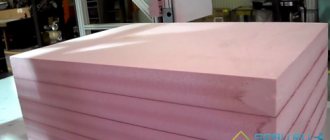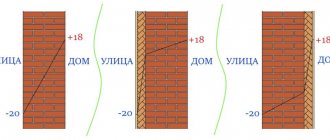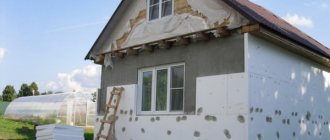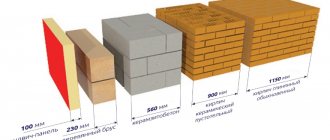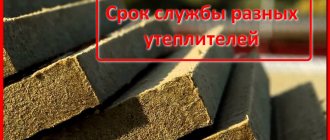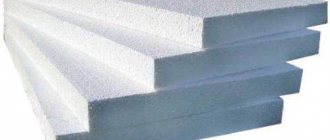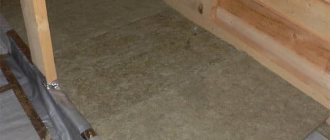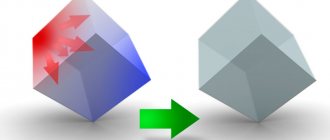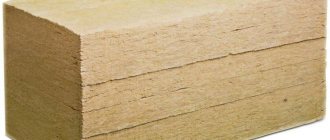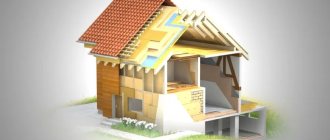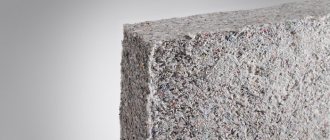Thermal insulation material is a product that is used for thermal insulation of buildings, structures and equipment. In specialized stores, insulators are presented in a wide range. When choosing thermal insulation, it is important to know information about the qualities of the material.
Insulation materials come in household and industrial types. They differ in the form of release, origin, and type of raw materials. They also have distinctive features in their characteristics. Thermal insulation characteristics include hygroscopicity.
Penoplex or mineral wool
Penoplex is a polystyrene derivative and is a product of organic chemistry. Mineral or basalt wool is a product of thermal processing of mineral raw materials. Both materials are successfully used in the creation of heat-insulating layers, but there are peculiarities in the use of each of them, which is explained by some physical indicators. Physical indicators of mineral wool:
- density – varies widely and can be from 10 to 300 kg/m3;
- thermal conductivity (at a density of about 35 kg/m3) – 0.040-0.045 W/m*K;
- moisture absorption – more than 1% (depending on density);
- vapor permeability – 0.4-0.5 mg/hour*m*Pa;
- maximum holding temperature 450 C and above.
Analysis of these values shows that the worse thermal conductivity of mineral wool is compensated by better vapor permeability, resistance to high temperatures and non-flammability. Usage min. cotton wool is justified precisely in those conditions where the listed parameters are important. It is advisable to use glass wool insulation in garages, workshops, industrial facilities, anywhere where there is an increased risk of fire. It is better to insulate wet rooms, such as saunas, baths and swimming pools, also using mineral insulation, since in this case the vapor permeability of the insulator is important.
The environmental safety of insulation based on polystyrene and mineral wool depends on the conditions of use. In case of fires, polystyrene derivatives can support combustion and emit toxic smoke. Mineral heat insulators are resistant to high temperatures and do not decompose, but over time they can age and release dust in the form of microfibers that make up the material. The external method of insulating walls using basalt wool is safe in this regard.
The insulation design must take into account possible exposure to water. Mineral materials are subject to greater fluid accumulation, and their thermal conductivity will be increased.
Other criteria for selecting insulation materials
Thermal insulation coating reduces heat loss by 30-40%, increases the strength of load-bearing structures made of brick and metal, reduces noise levels and does not take up the usable area of the building. When choosing insulation, in addition to thermal conductivity, other criteria must be taken into account.
Volume weight
The weight and density of mineral wool affects the quality of insulation.
This characteristic is related to thermal conductivity and depends on the type of material:
- Mineral wool products have a density of 30-200 kg/m3, so they are suitable for all building surfaces.
- Foamed polyethylene has a thickness of 8-10 mm. The density without foil is 25 kg/m3 with a reflective base - about 55 kg/m3.
- Polystyrene foam has a specific gravity of 80 to 160 kg/m3, and extruded polystyrene foam has a specific gravity of 28 to 35 kg/m3. The latter material is one of the lightest.
- Semi-liquid sprayed penoizol with a density of 10 kg/m3 requires preliminary plastering of the surface.
- Foam glass has a density associated with its structure. The foamed version is characterized by a volumetric weight from 200 to 400 kg/m3. Thermal insulation made of cellular glass - from 100 to 200 m3, which makes it possible to use it on facade surfaces.
The lower the volumetric weight, the less material is consumed.
Ability to keep fit
Plates and polyurethane foam have the same degree of rigidity and hold their shape well.
Manufacturers do not indicate dimensional stability on the packaging, but you can focus on Poisson’s and friction ratios, resistance to bending and compression. The stability of the shape is used to judge the creasing or change in parameters of the heat-insulating layer. In case of deformation, there is a risk of heat leakage by 40% through cracks and cold bridges.
The dimensional stability of building materials depends on the type of insulation:
- Cotton wool (mineral, basalt, eco) is straightened out when laid between the rafters. Due to the rigid fibers, deformation is eliminated.
- Foam types hold their shape at the level of hard stone wool.
The ability of a product to keep its shape is also determined by its elasticity characteristics.
Vapor permeability
Determines the “breathing” properties of the material - the ability to transmit air and steam. This indicator is important for controlling the indoor microclimate - more mold and mildew forms in mothballed rooms. In conditions of constant humidity, the structure may collapse.
Based on the degree of vapor permeability, there are two types of insulation:
- Foams are products for the production of which foaming technology is used. The product does not allow condensation to pass through at all.
- Cotton wool is thermal insulation based on mineral or organic fiber. Materials may allow condensation to pass through.
When installing vapor-permeable wool, a film vapor barrier is additionally laid.
Flammability
The indicator that is used to guide the construction of above-ground parts of residential buildings. The classification of toxicity and flammability is specified in Art. 13 Federal Law No. 123. The technical regulations highlight the following groups:
- NG – non-flammable: stone and basalt wool.
- G – flammable. Materials of category G1 (polyurethane foam) are characterized by low flammability, category G4 (expanded polystyrene, including extruded) are highly flammable.
- B – flammable: chipboards, roofing felt.
- D – smoke-generating (PVC).
- T – toxic (minimum level – paper).
The best option for private construction is self-extinguishing materials.
Soundproofing
Characteristics related to vapor permeability and density. Cotton wool prevents the penetration of extraneous noise into the room; more noise penetrates through the foam.
Dense materials have better sound insulation properties, but installation is complicated by thickness and weight. The best option for independent thermal insulation work would be stone wool with high sound absorption. Similar indicators are found in light glass wool or basalt insulation with twisted long thin fibers.
The normal sound insulation indicator is a density of 50 kg/m3.
Features of thermal conductivity
Expanded polystyrene retains not only heat, but also cold well.
Such possibilities are explained by its structure. The composition of this material structurally includes a huge number of sealed multifaceted cells. Each has a size from 2 to 8 mm. And inside each cell there is air, consisting of 98%. It is this that serves as an excellent heat insulator. The remaining 2% of the total mass of the material is made up of polystyrene cell walls. You can verify this if you take, for example, a piece of foam plastic. 1 meter thick and 1 square meter in area. Heat one side and leave the other side cold. The difference between temperatures will be tenfold. To obtain the thermal conductivity coefficient, it is necessary to measure the amount of heat that transfers from the warm part of the sheet to the cold part.
People are accustomed to constantly asking sellers about the density of polystyrene foam. This is because density and heat are closely related. Today, modern foam plastic does not require checking its density. The production of improved insulation involves the addition of special graphite substances. They make the thermal conductivity coefficient of the material unchanged.
Density and thermal conductivity of thermal insulation in the form of plates and segments
The table shows the density values and temperature dependence of the thermal conductivity of thermal insulation molded in the form of slabs, segments, etc., as well as their maximum operating temperature.
Thermal insulation density, thermal conductivity and temperature are indicated for such thermal insulation as: diatom segments, sovelite segments and shells, newel shells, asbestos cement segments, vulcanite slabs, vermiculite shells, foam concrete segments, foam glass slabs, cork segments, peat segments, mineral wool segments, alfol smooth sheets (segments), corrugated aluminum foil (segments), ball insulation backfilled into segments, rod thermal insulation backfilled into segments (porcelain rods with a diameter of 0.5 mm).
The lightest thermal insulation is alfol; according to the table, it has a density of 200 kg/m3 and a maximum operating temperature of up to 500°C. High-temperature thermal insulation (up to 2000°C) includes ball and rod insulation. However, such thermal insulation has a high density and low thermal conductivity, equal to 0.23...0.39 W/(m deg). The thermal conductivity of thermal insulation depends on temperature. The table presents formulas for the temperature dependence of thermal conductivity of thermal insulation and its maximum operating temperature.
Note: to calculate the thermal conductivity coefficient from the dependencies in the table, it is necessary to enter the temperature in degrees Celsius.
Comparative analysis of the main technical characteristics of basalt wool and expanded polystyrene
Fire resistance
Compared to expanded polystyrene, basalt wool has higher fire resistance. Basalt wool fibers are sintered at a temperature of about 1500 degrees. However, the maximum permissible temperature for use of this thermal insulation material in the form of mats and slabs is limited due to the binders that were used to form the finished products. At a temperature of about 600 degrees, the binders are destroyed, and the basalt slab or mat loses its integrity. It should be noted that polystyrene foam can withstand temperatures that do not exceed 75 degrees without any consequences.
Flammability
No less important is such an indicator as flammability - the ability of a material to burn. Modern building materials are usually divided into:
- non-flammable (NG) - able to withstand exposure to very high temperatures without ignition, loss of strength, deformation of the structure and changes in other properties.
- flammable (G) - the degree of flammability is determined by such indicators as flammability, smoke generation ability, flame spread, toxicity.
It is important to note that if materials of class NG are not only completely fireproof, but also prevent the spread of fire, then materials of class G always pose a fire hazard.
The flammability of basalt wool, which is based on inorganic materials that by their nature cannot burn, is determined depending on the amount of organic binders used in the production of insulation. High-quality basalt wool (for example, the Beltep brand) contains no more than 4.5% binders, therefore it is assigned the NG group. In the case of a higher content of organic substances, the flammability group of basalt wool changes to group G1 (lowly flammable materials) or G2 (moderately flammable materials).
Expanded polystyrene, regardless of the type of material, always belongs to class G. Moreover, the flammability group of this thermal insulation material can vary from G1 (lowly flammable material) to G4 (highly flammable material).
Water absorption
Basalt wool has open porosity, therefore it is able to absorb moisture (up to 2% by volume, and up to 20% by weight). And since water is an excellent conductor of heat, when moisture gets in, the thermal insulation characteristics of basalt wool significantly deteriorate (up to complete unsuitability). And although manufacturers treat basalt wool with water-repellent additives that prevent moisture absorption, experts recommend reliably protecting this thermal insulation material from moisture with vapor and waterproofing barriers.
Unlike basalt wool, polystyrene foam has a closed closed porosity, therefore it is characterized by high resistance to capillary water absorption (up to 0.4% by volume) and water vapor diffusion.
Strength
Strength characteristics mean such indicators as the strength of the material to peel off layers, compression at 10% deformation, shear/shear, bending, etc.
The strength characteristics of basalt wool depend on the density of the material and the amount of binders. For expanded polystyrene, these indicators depend solely on the density of the material. At the same time, expanded polystyrene is characterized by higher compressive strength at 10% deformation than basalt wool with a lower density (for example, the compressive strength at 10% deformation of expanded polystyrene with a density of 35-45 kg/m3 is about 0.25-0.50 MPa, while for basalt wool with a density of 80-190 kg/m3 this figure ranges from 0.15-0.70 MPa). Note that for basalt wool with a density of 11-70 kg/m3, it is not the strength characteristics that are measured, but the compressibility value under a load of 2000 Pa.
Thermal conductivity
One of the most important indicators of any thermal insulation material is its thermal conductivity. Research has shown that both materials we are considering have almost the same thermal conductivity: for basalt wool - 0.033-0.043 W/m•°C, for expanded polystyrene - 0.028-0.040 W/m•°C. Note, however, that air has the lowest thermal conductivity (0.026 W/m•°C), and both one and the other thermal insulation material are effective insulation.
Using wool of different densities for insulation
The choice of insulation according to the indicator under consideration depends on the place of its use. It is not always necessary to overpay in order to get the desired result. Most often, the facade, walls, roof and floor are insulated. These are the options that are worth considering.
Regardless of density, the material must be protected from moisture
Facade
When selecting insulation for a facade, you need to pay attention to the mass and density of mineral wool. For most buildings, weighting is very undesirable. It is also worth paying attention to the possibility of subsequent finishing, because this indicator also affects this. So:
- If the facade is equipped with a ventilated one, then a sufficient density is 45-100 kg m³. Here the cotton wool is laid into the sheathing and there will be virtually no stress. The main tasks for this type are to maintain its shape and not sag under its own weight, and the indicated indicator is enough for this.
- If the facade will be plastered over insulation, then the density should be above 100 kg m³, optimally from 145 to 165. This will allow the use of any types of plaster mixtures, including bark beetle, barenkom and even mosaics. Since this mineral wool will have to withstand heavy loads during installation, it must be securely fastened; for this, a system with dowels is used in combination with adhesive fastening.
Wall insulation
In this case, the selection is made based on ease of installation, that is, the density should be at least 30-45 kg m³. In this case, you need to insulate from the inside; MDF boards or drywall should be screwed onto the material on top. In order to mount such mineral wool, you need a lathing; rolls or sheets are placed in it.
Roof
Since roof insulation work is carried out at heights, the main criteria when selecting mineral wool are light weight and ease of use. Material with a density of 30-35 kg m³ can be pleased with these qualities. Its sound and heat insulation properties will be excellent, and at the same time light weight. Installation can be carried out using two methods:
- Using a construction stapler.
- In the lathing with a vapor barrier closure.
Thermal conductivity concept and theory
Thermal conduction is the process of moving thermal energy from heated parts to cold parts. Metabolic processes occur until the temperature reaches complete equilibrium.
A comfortable microclimate in the house depends on high-quality thermal insulation of all surfaces
The heat transfer process is characterized by a period of time during which temperature values are equalized. The more time passes, the lower the thermal conductivity of building materials, the properties of which are shown in the table. To determine this indicator, a concept called thermal conductivity coefficient is used. It determines how much thermal energy passes through a unit area of a certain surface. The higher this indicator, the faster the building will cool. A thermal conductivity table is needed when designing the protection of a building from heat loss. This can reduce the operating budget.
Heat losses in different areas of the building will differ
Table of thermal conductivity coefficients of different materials
Based on the table with the thermal conductivity coefficients of building materials and popular insulation materials, a comparative analysis can be made. It will ensure the selection of the optimal thermal insulation option for the building.
| Material | Thermal conductivity, W/m*K | Thickness, mm | Density, kg/m³ | Laying temperature, °C | Vapor permeability, mg/m²*h*Pa |
| Polyurethane foam | 0,025 | 30 | 40-60 | -100 to +150 | 0,04-0,05 |
| Extruded polystyrene foam | 0,03 | 36 | 40-50 | -50 to +75 | 0,015 |
| Styrofoam | 0,05 | 60 | 40-125 | -50 to +75 | 0,23 |
| Mineral wool (slabs) | 0,047 | 56 | 35-150 | -60 to +180 | 0,53 |
| Fiberglass (slabs) | 0,056 | 67 | 15-100 | From +60 to +480 | 0,053 |
| Basalt wool (slabs) | 0,037 | 80 | 30-190 | -190 to +700 | 0,3 |
| Reinforced concrete | 2,04 | 2500 | 0,03 | ||
| Hollow brick | 0,058 | 50 | 1400 | 0,16 | |
| Wooden beams with cross section | 0,18 | 15 | 40-50 | 0,06 |
For thickness parameters, an average value was used.
Thermal conductivity of polystyrene foam from 50 mm to 150 mm is considered thermal insulation
Expanded polystyrene boards, colloquially referred to as polystyrene foam, are an insulating material, usually white. It is made from thermally expanded polystyrene. In appearance, the foam is presented in the form of small moisture-resistant granules; during the melting process at high temperatures, it is smelted into one whole, a slab. The sizes of the granule parts are considered to be from 5 to 15 mm. The outstanding thermal conductivity of 150 mm thick foam is achieved due to a unique structure - granules.
Each granule has a huge number of thin-walled micro-cells, which in turn increase the area of contact with air many times over. We can say with confidence that almost all polystyrene foam consists of atmospheric air, approximately 98%, in turn, this fact is their purpose - thermal insulation of buildings both outside and inside.
Everyone knows, even from physics courses, that atmospheric air is the main insulator of heat in all thermal insulation materials; it is in a normal and rarefied state, in the thickness of the material. Heat-saving, the main quality of polystyrene foam.
As mentioned earlier, polystyrene foam is almost 100% air, and this in turn determines the high ability of polystyrene foam to retain heat. This is due to the fact that air has the lowest thermal conductivity. If we look at the numbers, we will see that the thermal conductivity of polystyrene foam is expressed in the range of values from 0.037 W/mK to 0.043 W/mK. This can be compared with the thermal conductivity of air - 0.027 W/mK.
While the thermal conductivity of popular materials such as wood (0.12 W/mK), red brick (0.7 W/mK), expanded clay (0.12 W/mK) and others used for construction is much higher.
Therefore, polystyrene foam is considered to be the most effective material among the few for thermal insulation of external and internal walls of a building. Residential heating and cooling costs are significantly reduced through the use of polystyrene foam in construction.
The excellent qualities of polystyrene foam boards have found their application in other types of protection, for example: polystyrene foam, which also serves to protect underground and external communications from freezing, due to which their service life increases significantly. Polystyrene foam is also used in industrial equipment (refrigerators, refrigerators) and in warehouses.
Who is the warmest in the world?
The purpose of such a thorough study of insulation is one - to find out which one is the best. However, this is a double-edged sword, as materials with high thermal insulation may have other undesirable characteristics.
Polyurethane foam or extruded polystyrene foam
It is easy to determine from the table that the champion in thermal insulation is polyurethane foam .
But its price is much higher than that of polystyrene or polystyrene. This is because it has two of the most sought-after qualities in construction: non-flammability and water-repellent properties. It is difficult to set fire to, so the fire safety of such insulation is high, and it is not afraid of getting wet. But polyurethane foam has a real alternative - extruded polystyrene foam. Essentially, this is the same foam plastic, but it has undergone additional processing - extrusion, which has improved it. This is a material with a uniform structure and closed cells, which is presented in the form of sheets of different thicknesses. It is distinguished from conventional polystyrene foam by its enhanced strength and ability to withstand mechanical pressure. That is why it can be called a worthy competitor to polyurethane foam. The only drawback to installing individual slabs is the seams, which can be successfully sealed with polyurethane foam.
As for what is more convenient for you to use – liquid insulation from a can or slabs – it’s up to you to choose. But remember that these materials do not “breathe” and can create the effect of fogged windows, so that all the insulation can leave the window during ventilation. Therefore, it is necessary to insulate with such materials wisely.
Mineral wool or polystyrene foam
If we compare mineral wool and polystyrene foam, their thermal conductivity is at the same level ≈ 0.5. Therefore, when choosing between these materials, it would be nice to evaluate other qualities, such as water permeability. Thus, installing wool in places with possible wetness is undesirable, since it loses its thermal insulation properties by 50% when wet by 20%. On the other hand, cotton wool “breathes” and allows steam to pass through, so condensation will not form . In a house that is insulated with basalt fiber wool, windows will not fog up. And cotton wool, unlike polystyrene foam, does not burn.
Other insulation materials
Eco-friendly materials such as sawdust, which are mixed with clay and used for walls, are very popular now. However, such an affordable material as sawdust has many disadvantages: it burns, gets wet and rots. Not to mention the fact that when sawdust gains moisture, it loses its thermal insulation properties.
Cheap and environmentally friendly foam glass is also gaining popularity, which can only be used without loads, since it is very fragile.
Main characteristics of insulation
Let us first provide the characteristics of the most popular thermal insulation materials, which you should first pay attention to when choosing. Comparison of insulation by thermal conductivity should be made only on the basis of the purpose of the materials and room conditions (humidity, presence of open fire, etc.)
We have further arranged in order of importance the main characteristics of insulation.
Comparison of building materials
Thermal conductivity. The lower this indicator, the less thermal insulation layer is required, which means that insulation costs will also be reduced.
Moisture permeability. The lower permeability of the material to moisture vapor reduces the negative impact on the insulation during operation.
Fire safety. Thermal insulation should not burn or emit toxic gases, especially when insulating a boiler room or chimney.
Durability. The longer the service life, the cheaper it will cost you during operation, since it will not require frequent replacement.
Environmentally friendly. The material must be safe for humans and the environment.
Basic criteria and building standards
The lower the density of mineral wool, the lower the thermal conductivity and the higher the sound insulation.
The thermal transfer resistance of the walls of buildings under construction is regulated by the current standards of SNB 2.04.01 (Chapter 5.1), which provides information for all types of walls and ceilings. In addition, for external fences and coatings, parameters for air and vapor permeability must be calculated. In multilayer protective structures, the materials used are calculated as a single whole, consistent with the main technical indicators.
The selection of products that are supposed to be used to insulate walls is preceded by thermal engineering calculations. Based on their results, the type of material needed and its specific brand are determined. When using synthetic substances (polystyrene or polyethylene), it is taken into account that they are impermeable not only to water, but also to steam. Therefore, when choosing them, it will be necessary to take special measures to create good air exchange in the rooms.
Materials formed into slabs (including glass wool) have special requirements:
- the geometry is chosen so that the corners and edges of the workpieces do not have clearly visible damage and noticeable irregularities;
- the structure of the slabs is dense, the presence of poorly connected fibers and falling out granules is considered completely unacceptable;
- the surfaces on both sides are made rough, or one of them is made with a complex texture.
Fulfillment of the last requirement guarantees good adhesion to insulated walls.
Comparison of insulation materials by thermal conductivity
Expanded polystyrene (foam)
Expanded polystyrene (foam) slabs
This is the most popular thermal insulation material in Russia, due to its low thermal conductivity, low cost and ease of installation. Polystyrene foam is produced in slabs with a thickness of 20 to 150 mm by foaming polystyrene and consists of 99% air. The material has different densities, has low thermal conductivity and is resistant to humidity.
Due to its low cost, expanded polystyrene is in great demand among companies and private developers for insulating various premises. But the material is quite fragile and ignites quickly, releasing toxic substances when burned. Because of this, it is preferable to use polystyrene foam in non-residential premises and for thermal insulation of non-loaded structures - insulation of facades under plaster, basement walls, etc.
Extruded polystyrene foam
Penoplex (extruded polystyrene foam)
Extrusion (technoplex, penoplex, etc.) is not exposed to moisture and rotting. This is a very durable and easy-to-use material that can be easily cut with a knife to the desired size. Low water absorption ensures minimal changes in properties at high humidity; the slabs have high density and compression resistance. Extruded polystyrene foam is fireproof, durable and easy to use.
All these characteristics, along with low thermal conductivity in comparison with other insulation materials, make Technoplex, URSA XPS or Penoplex slabs an ideal material for insulating strip foundations of houses and blind areas. According to the manufacturers, an extrusion sheet 50 millimeters thick replaces 60 mm of foam block in terms of thermal conductivity, while the material does not allow moisture to pass through and you can do without additional waterproofing.
Mineral wool
Izover mineral wool slabs in packaging
Mineral wool (for example, Izover, URSA, Tekhnoruf, etc.) is produced from natural materials - slag, rocks and dolomite using special technology. Mineral wool has low thermal conductivity and is absolutely fireproof. The material is produced in slabs and rolls of varying hardness. Less dense mats are used for horizontal planes; rigid and semi-rigid slabs are used for vertical structures.
However, one of the significant disadvantages of this insulation, like basalt wool, is low moisture resistance, which requires additional moisture and vapor barrier installations when installing mineral wool. Experts do not recommend using mineral wool for insulation of wet rooms - basements of houses and cellars, for thermal insulation of steam rooms from the inside in baths and dressing rooms. But even here it can be used with proper waterproofing.
Basalt wool
Rockwool basalt wool slabs in packaging
This material is produced by melting basalt rocks and blowing the molten mass with the addition of various components to obtain a fibrous structure with water-repellent properties. The material is non-flammable, safe for human health, and has good thermal insulation and sound insulation properties. It is used for both internal and external thermal insulation.
When installing basalt wool, you should use protective equipment (gloves, a respirator and goggles) to protect the mucous membranes from cotton wool microparticles. The most famous brand of basalt wool in Russia is materials under the Rockwool brand. During operation, the thermal insulation slabs do not compact or cake, which means that the excellent properties of low thermal conductivity of basalt wool remain unchanged over time.
Penofol, isolon (foamed polyethylene)
Penofol and isolon are roll insulation materials with a thickness of 2 to 10 mm, consisting of polyethylene foam. The material is also available with a layer of foil on one side to create a reflective effect. The insulation is several times thinner than previously presented insulation materials, but at the same time retains and reflects up to 97% of thermal energy. Foamed polyethylene has a long service life and is environmentally friendly.
Isolon and foil penofol are lightweight, thin and very easy to use thermal insulation materials. Roll insulation is used for thermal insulation of wet rooms, for example, when insulating balconies and loggias in apartments. Also, the use of this insulation will help you save useful space in the room when insulating inside. Read more about these materials in the section “Organic thermal insulation”.
Comparison of thermal insulation materials
The most popular materials for installation are polyurethane foam and penoizol. The widespread use of these materials in construction is due to their low cost and excellent thermal insulation.
The waterproofing properties of penoizol allow it to be used as a roofing material.
Only vacuum insulation is more effective than polyurethane foam, and this is very expensive.
Polyurethane foam can be used in ready-made thermal insulation parts - blocks, panels. And it can be used in special compositions that are sprayed onto almost any surface: wood, glass, metal, concrete, brick, paint. As a result, there is no need to make fasteners for insulation.
Expanded polystyrene competes with polyurethane foam. Due to its low weight, even a thick layer of foam does not exert a significant load on the supporting structures. Consists of closed cells, tightly structured.
You can insulate with foam plastic:
- Exterior walls;
- Roofs;
- Floors;
- Pipelines.
To install polystyrene foam on vertical sections, it is not necessary to attach a frame. Rigid sheets of insulation can be glued to the surface or fastened mechanically.
Another one of the most popular modern materials is foil polyethylene. The bottom layer is covered with foamed polyethylene. The top layer is covered with aluminum foil, which reflects heat up to 97%.
This type of insulation is used in the construction of heated floors, for sound insulation of ventilation shafts, pipelines, and expansion tanks. The material does not allow steam and water to pass through. It insulates heat and sound at the same time. In this case, it is laid in a thin layer.
One layer of 4 mm polyethylene can replace 8 cm thick mineral wool.
Distinctive features of PPE insulation
Specifications
Thermal insulation made of foamed polyethylene is a product with a closed-porous structure, soft and elastic, having a shape appropriate for its purpose. They have a number of properties that characterize gas-filled polymers:
- Density from 20 to 80 kg/m3,
- Operating temperature range from -60 to +100 0C,
- Excellent moisture resistance, in which moisture absorption is no more than 2% of the volume, and almost absolute vapor tightness,
- High noise absorption even with a thickness greater than or equal to 5 mm,
- Resistant to most chemically active substances,
- No rotting or fungal damage,
- Very long service life, in some cases reaching more than 80 years,
- Non-toxic and environmentally safe.
But the most important characteristic of polyethylene foam materials is their very low thermal conductivity, due to which they can be used for thermal insulation purposes. As you know, air retains heat best, and there is plenty of it in this material.
The heat transfer coefficient of polyethylene foam insulation is only 0.036 W/m2 * 0C (for comparison, the thermal conductivity of reinforced concrete is about 1.69, plasterboard - 0.15, wood - 0.09, mineral wool - 0.07 W/m2 * 0C).
INTERESTING! Thermal insulation made of foamed polyethylene with a layer thickness of 10 mm can replace a 150 mm thickness of brickwork.
Application area
Foamed polyethylene insulation is widely used in new and reconstructive construction of residential and industrial facilities, as well as in automotive and instrument making:
- To reduce heat transfer by convection and thermal radiation from walls, floors and roofs,
- As reflective insulation to increase the heat output of heating systems,
- To protect pipe systems and pipelines for various purposes,
- In the form of an insulating gasket for various cracks and openings,
- For insulating ventilation and air conditioning systems.
In addition, polyethylene foam is used as packaging material for transporting products that require thermal and mechanical protection.
Is polyethylene foam harmful?
Supporters of the use of natural materials in construction may talk about the harmfulness of chemically synthesized substances. Indeed, when heated above 120 0C, foamed polyethylene turns into a liquid mass, which can be toxic. But under standard living conditions it is absolutely harmless. Moreover, insulation materials made from polyethylene foam are superior to wood, iron and stone in most respects. Building structures using them are light, warm and low cost.
What properties of Penoplex determine the high level of consumer demand?
When choosing a material, its unique low thermal conductivity, light weight, simple installation and long service life are taken into account.
- New generation extruded polystyrene foam thermal insulation differs from polystyrene foam in its perfectly homogeneous structure, resistance to compression loads and other adverse external influences.
- For all its advantages, mineral wool has strict weight restrictions. Therefore, to insulate devices that do not have a sufficient safety margin, lightweight materials based on polystyrene foam are used.
The disadvantages of Penoplex Facade, which you can buy from our company at any time of the year - zero vapor permeability and fairly low heat resistance, are partially or fully compensated by the use of façade systems with slot ventilation and the installation of heat-resistant protective and decorative coatings.
As for the insulation of underground structures, including foundation ones, in this case moisture- and frost-resistant polystyrene foam does not have a worthy alternative.
The strength of the foundation lining is sufficient to protect the waterproofing from damage by seasonal movements of heaving soils. The range of polystyrene foam insulation includes panels of different sizes: from 30 to 100 mm thick. In most central regions, panels with a thickness of 50-60 mm are in high demand. You can buy Penoplex 50 mm in Moscow with significant discounts at promotional and seasonal sales of building materials.
Thermal conductivity of polystyrene foam in comparison
If you compare polystyrene foam with many other building materials, you can draw colossal conclusions.
The thermal conductivity of foam plastic ranges from 0.028 to 0.034 watts per meter/Kelvin. If the density increases, the thermal insulation properties of extruded polystyrene foam without graphite additives decrease.
A 2 cm layer of extruded foam can retain heat like a 3.8 cm layer of mineral wool, like a 3 cm layer of regular polystyrene foam, or like a 20 cm thick wooden board. For brick, these abilities are equivalent to a wall thickness of 37 cm. For foam concrete – 27 cm.
Inorganic options
Along with organic TIMs, inorganic insulators are also widely used. They are based on various mineral components - glass, slag, rocks, asbestos and others. As a result of processing these elements, various heat insulators are obtained. The leader in the field of inorganic insulation is, of course, mineral wool.
Mineral wool
This material is available in two varieties. Slag mineral wool is made from various wastes of ferrous and non-ferrous metallurgy. Stone wool is based on various rocks - limestone, basalt, etc. Phenols or ureas are used to bind elements. Mineral wool is produced in the form of rolls or blocks.
The positive properties of this insulator include:
- low density with excellent thermal insulation characteristics;
- zero flammability;
- high level of noise absorption;
- long service life.
The disadvantages of this material include high vapor permeability. Therefore, it must be laid in conjunction with a high-quality vapor barrier layer.
Glass wool
The raw material for glass wool is glass and glass production waste. Thanks to its thick and long fibers, glass wool is stronger and more resilient than mineral wool.
When heated, glass wool does not emit harmful substances, has good noise absorption and thermal conductivity characteristics, and is also resistant to aggressive substances. Available in rolls.
Ceramic wool
Aluminum, silicon or zirconium oxide gave the consumer an excellent thermal insulation material called ceramic wool. It is produced using a centrifuge. At high speeds, the starting materials are inflated, which, after cooling, are shaped into rolls.
Ceramic wool is not afraid of high temperatures, so it can be placed on roofs or in rooms with large temperature differences. It does not deform, does not burn and is not afraid of chemically active influences. The density of this TIM is about 350 kg/m3, thermal conductivity is up to 0.16 W/m per Kelvin.
Indicators for different brands of polystyrene foam
From the given simplified formula we can conclude that the thinner the insulation sheet, the less efficient it is. But in addition to the usual geometric parameters, the density of the foam also affects the final result, albeit slightly - only within 1-5 thousandths. For comparison, let’s take two slabs of similar brand:
- PSB-S 25 conducts 0.039 W/m°C.
- PSB-S 35 at a higher density - 0.037 W/m °C.
But with a change in thickness, the difference becomes much more noticeable. For example, the thinnest sheets of 40 mm with a density of 25 kg/m 3 can have a thermal conductivity of 0.136 W/m°C, while 100 mm of the same polystyrene foam transmits only 0.035 W/m°C.
Comparison with other materials
The average thermal conductivity of PSB lies in the range of 0.037-0.043 W/m·°C, and we will focus on it. Here, foam plastic, in comparison with mineral wool made from basalt fibers, seems to benefit slightly - it has approximately the same indicators. True, with twice the thickness (95-100 mm versus 50 mm for polystyrene). It is also customary to compare the conductivity of insulation with the various building materials necessary for the construction of walls. Although this is not very correct, it is very clear:
1. Red ceramic brick has a heat transfer coefficient of 0.7 W/m °C (16-19 times more than foam). Simply put, to replace 50 mm of insulation you will need masonry about 80-85 cm thick. Silicate insulation will need at least a meter.
2. Solid wood is better in this regard compared to brick - here it is only 0.12 W/m °C, that is, three times higher than that of expanded polystyrene. Depending on the quality of the wood and the method of constructing the walls, the equivalent of a 5 cm thick PSB can be a log house up to 23 cm wide.
It is much more logical to compare styrene not with mineral wool, brick or wood, but to consider closer materials - polystyrene foam and Penoplex. Both of them are classified as foamed polystyrene and are even made from the same granules. It’s just that the difference in the technology of “gluing” them gives unexpected results. The reason is that styrene beads for the production of Penoplex with the introduction of blowing agents are simultaneously processed under pressure and high temperature. As a result, the plastic mass acquires greater homogeneity and strength, and air bubbles are evenly distributed in the body of the slab. Polystyrene foam is simply steamed in a mold like popcorn, so the bonds between the expanded granules are weaker.
As a result, the thermal conductivity of Penoplex, an extruded “relative” of PSB, also improves noticeably. It corresponds to 0.028-0.034 W/m °C, that is, 30 mm is enough to replace 40 mm of foam. However, the complexity of production also increases the cost of XPS, so you should not count on savings. By the way, there is one curious nuance here: usually extruded polystyrene foam loses a little in efficiency as its density increases. But when graphite is added to Penoplex, this dependence practically disappears.
Prices for foam plastic sheets 1000x1000 mm (rubles):
Review of hygroscopicity of thermal insulation
High hygroscopicity is a disadvantage that needs to be eliminated.
Hygroscopicity is the ability of a material to absorb moisture, measured as a percentage of its own weight of insulation. Hygroscopicity can be called the weak side of thermal insulation and the higher this value, the more serious measures will be required to neutralize it. The fact is that water, getting into the structure of the material, reduces the effectiveness of the insulation. Comparison of hygroscopicity of the most common thermal insulation materials in civil engineering:
| Name of material | Moisture absorption,% by weight |
| Minvata | 1,5 |
| Styrofoam | 3 |
| PPU | 2 |
| Penoizol | 18 |
| Ecowool | 1 |
A comparison of the hygroscopicity of home insulation showed the high moisture absorption of foam insulation, while this thermal insulation has the ability to distribute and remove moisture. Thanks to this, even when wet by 30%, the thermal conductivity coefficient does not decrease. Despite the fact that mineral wool has a low percentage of moisture absorption, it especially needs protection. Having absorbed the water, it holds it, preventing it from leaving. At the same time, the ability to prevent heat loss is catastrophically reduced.
To prevent moisture from entering the mineral wool, vapor barrier films and diffusion membranes are used. Basically, polymers are resistant to prolonged exposure to moisture, with the exception of ordinary polystyrene foam, which quickly deteriorates
In any case, water does not benefit any thermal insulation material, so it is extremely important to exclude or minimize their contact
What you need to know about the thermal conductivity of foam plastic
The ability of a material to transfer heat, conduct or retain heat flows is usually assessed by the thermal conductivity coefficient. If you look at its dimension - W/m∙C o , it becomes clear that this is a specific value, that is, determined for the following conditions:
- The absence of moisture on the surface of the slab, that is, the thermal conductivity coefficient of polystyrene foam from the reference book, is a value determined in ideally dry conditions, which practically do not exist in nature, except perhaps in the desert or Antarctica;
- The value of the thermal conductivity coefficient is given for a foam thickness of 1 meter, which is very convenient for theory, but somehow not impressive for practical calculations;
- The results of measuring thermal conductivity and heat transfer were carried out for normal conditions at a temperature of 20 o C.
According to a simplified method, when calculating the thermal resistance of a layer of foam insulation, you need to multiply the thickness of the material by the thermal conductivity coefficient, then multiply or divide by several coefficients used to take into account the actual operating conditions of the thermal insulation. For example, strong watering of the material, or the presence of cold bridges, or the method of installation on the walls of the building.
How the thermal conductivity of polystyrene foam differs from other materials can be seen in the comparison table below.
It's actually not that simple. To determine the thermal conductivity value, you can create it yourself or use a ready-made program for calculating insulation parameters. For a small object this is usually done. A private owner or self-builder may not be interested in the thermal conductivity of the walls at all, but rather lay insulation from foam plastic material with a margin of 50 mm, which will be quite enough for the harshest winters.
Large construction companies that insulate walls covering an area of tens of thousands of square meters prefer to act more pragmatically. The calculation of the insulation thickness is used to draw up an estimate, and the actual thermal conductivity values are obtained on a full-scale object. To do this, glue several sheets of foam plastic of different thicknesses onto a section of the wall and measure the actual thermal resistance of the insulation. As a result, it is possible to calculate the optimal thickness of the foam with an accuracy of several millimeters; instead of approximately 100 mm of insulation, you can lay the exact value of 80 mm and save a considerable amount of money.
How beneficial the use of polystyrene foam is in comparison with standard materials can be assessed from the diagram below.
Rules for installing mineral wool slabs
Preparation for installing mineral wool slabs or rolls includes a number of procedures, among which the following should be highlighted:
- Cleaning surfaces from traces of mold using a construction spatula, if necessary, treating the surface with an antiseptic.
- Sealing of holes and cracks, carried out using cement mortar, sealing of deep voids with the help of polyurethane foam and tow.
- Treatment with antiseptic agents and primer, it is important to maintain the recommended time between applying different layers so that each of them has time to dry.
- At the last stage of preparation, the flatness of the surface is ensured, which is necessary for a tight fit of frameless insulation to it.
- After completion of preparation, an adhesive solution for fastening rolls applied in a spot manner ensures the creation of an air gap.
- Starting from the top of the wall in a horizontal direction, using a furniture stapler or double-sided tape, install the vapor barrier film to the frame.
- After this, the joints are glued using construction tape or mounting tape.
- Then the sheathing is carried out using slats having a width of about 1.5–2.5 cm, which is necessary to create a ventilation gap between the inner lining and the vapor barrier layer.
- At the next stage, the required length of the rigid mineral wool , taking into account a tolerance of 10 cm, and its installation on the surface of the facade by pressing the brackets on the frame with the bent ears, ensuring reliable fixation of the insulation in a vertical position.
- At the last stage of installation, the final finishing is carried out, for example, profiles are installed and sheets are installed, made of plasterboard or plaster is applied.
Note! Builders consider it more preferable than using material in rolls to use rigid mineral wool slabs for finishing vertical surfaces. This is due to the lack of rolling of the insulation, however, before installing it, it is recommended to first install the strips in a horizontal direction to reduce their weight.
Using thermal conductivity values in practice
Materials used in construction can be structural and thermal insulating.
There are a huge number of materials with thermal insulating properties
The highest thermal conductivity value is for structural materials that are used in the construction of floors, walls and ceilings. If you do not use raw materials with heat-insulating properties, then to retain heat you will need to install a thick layer of insulation for the construction of walls.
Often simpler materials are used to insulate buildings
Therefore, when constructing a building, it is worth using additional materials. In this case, the thermal conductivity of building materials is important; the table shows all the values.
In some cases, insulation from the outside is considered more effective.
Conclusion
The choice of thermal insulation is an important stage of construction. To choose the right material, you need to consider the following factors:
- type of work (internal or external); method of installation of insulation (horizontal or vertical); load on the thermal insulation material; whether it is used for sound insulation; average temperature in the cold season, etc.
It is important to take into account not only the mass pressure per unit volume, but also the structure of the insulation, the features of its manufacture and use.
The way the thermal insulation material wears out over time also plays an important role. Mineral wool, for example, tends to absorb moisture, which leads to a gradual increase in thermal conductivity. It also crumbles and crumbles, causing it to become thinner at the top.
The room to be insulated also influences the choice of material. Thus, for outbuildings it is not enough to choose a high-density thermal insulation material. It is necessary to install one that will not be destroyed by small rodents and insects.
As you can see, the density indicator is an important criterion when choosing insulation, but not decisive.
Both yesterday and today, mineral wool is one of the in-demand insulation materials, both among private developers and professional builders. This popularity is due to its excellent heat-saving and fire-fighting properties, as well as ease of installation and a wide range of possibilities.
However, in order to use mineral wool correctly and with the greatest efficiency, it is necessary to understand its characteristics. In this regard, the most important indicator is the density of mineral wool, on which its thermal insulation qualities depend.
What is the thermal conductivity of polystyrene foam Properties and characteristics
Thermal conductivity is a value indicating the amount of heat (energy) passing through 1 m of any body per hour at a certain temperature difference on one side and the other. It is measured and calculated for several initial operating conditions:
- At 25±5 °C - this is a standard indicator enshrined in GOSTs and SNiP.
- “A” – this means dry and normal humidity conditions in the premises.
- “B” – all other conditions are included in this category.
The actual thermal conductivity of polystyrene foam granules pressed into a lightweight slab is not as important in itself as in conjunction with the thickness of the insulation. After all, the main goal is to achieve an optimal level of resistance of all layers of the wall in accordance with the requirements for a particular region. To obtain the initial numbers, it will be enough to use the simplest formula: R = p÷k.
- Heat transfer resistance R can be found in special tables of SNiP 23-02-2003, for example, for Moscow they take 3.16 m ° C / W. And if the main wall, according to its characteristics, does not reach this value, it is the insulation (mineral wool or the same polystyrene foam) that should cover the difference.
- The p index indicates the required thickness of the insulating layer, expressed in meters.
- Coefficient k is precisely what gives an idea of the conductivity of bodies, which we focus on when choosing.
The thermal conductivity of the material itself is checked by heating one side of the sheet and measuring the amount of energy transferred by conduction to the opposite surface per unit time.
Where bulk and organic materials are used
Bulk and organic materials are used in construction. Bulk materials include expanded perlite.
Characteristics:
- Incombustible;
- Environmentally friendly material;
- Not susceptible to water.
It is used for the production of lightweight concrete and thermal insulation products, for insulation of ceilings and floors. More suitable for horizontal surfaces.
Organic materials include flax and cork. They are safe for people, but are flammable materials. Therefore, polyurethane foam, penoizol and mineral wool can be called advantageous in their characteristics for finishing materials. They are affordable to consumers, practical, and have a long service life.
Features of the production of basalt wool and expanded polystyrene
The production of basalt wool is based on the melt of rocks of the gabbro-basalt group. Melting occurs in furnaces at temperatures above 1500 degrees. The resulting melt is transformed into thin fibers, from which a mineral wool carpet is formed. Then the mineral wool carpet is treated with binders and heat treated in a polymerization chamber, resulting in finished products - mats and slabs.
Expanded polystyrene is a lightweight gas-filled polystyrene-based material, which is characterized by a uniform structure consisting of small (0.1-0.2 mm) completely closed cells. Today, the construction market offers two types of this material: regular and extruded polystyrene foam. The main difference between these two types of expanded polystyrene is the production technology, and, as a consequence, the properties of the finished product.
Conventional polystyrene foam is formed by sintering granules under high temperatures.
Extruded polystyrene foam is made by swelling and welding granules under the influence of hot steam or water (temperature 80-100 degrees) and subsequent extrusion through an extruder.
The main difference between extruded polystyrene foam and regular polystyrene is its higher rigidity and lower water absorption. Another difference is due to the production technology - the limitation on the thickness of the slabs (maximum 100 mm) made from extruded polystyrene foam.
If you explain it on your fingers
For clarity and understanding of what thermal conductivity is, you can compare a brick wall, 2 m 10 cm thick, with other materials. Thus, 2.1 meters of brick laid into a wall using ordinary cement-sand mortar is equal to:
- a 0.9 m thick wall made of expanded clay concrete;
- timber, diameter 0.53 m;
- wall, 0.44 m thick, made of aerated concrete.
If we are talking about such common insulation materials as mineral wool and expanded polystyrene, then only 0.18 m of the first thermal insulation or 0.12 m of the second is required for the thermal conductivity values of a huge brick wall to be equal to a thin layer of thermal insulation.
Comparative characteristics of the thermal conductivity of insulating, building and finishing materials, which can be done by studying SNiPs, allows you to analyze and correctly compose an insulating cake (base, insulation, finishing). The lower the thermal conductivity, the higher the price. A striking example is the walls of a house made of ceramic blocks or ordinary high-quality bricks. The former have a thermal conductivity of only 0.14 - 0.18 and are much more expensive than any of the best bricks.
Different materials have different thermal conductivity, and the lower it is, the less heat exchange between the internal environment and the external environment. This means that such a house remains warm in winter and cool in summer.
Thermal conductivity is a quantitative characteristic of the ability of bodies to conduct heat. In order to be able to make comparisons, as well as accurate calculations during construction, we present the figures in the table of thermal conductivity, as well as strength and vapor permeability of most building materials.
Thermal conductivity of foam
The main characteristic due to which expanded polystyrene has gained wide recognition as the No. 1 insulation material is the ultra-low thermal conductivity of foam. The relatively low strength of the material is more than compensated by such advantages as resistance to most aggressive compounds, low weight, non-toxicity and safety during operation. The good thermal insulation properties of polystyrene foam make it possible to insulate a house at a relatively low price, while the durability of such insulation is designed for a period of at least 25 years of service.
Selecting insulation density
Before deciding which insulation density to choose, you need to determine where it will be installed.
If you plan to insulate the walls, the type of cladding plays an important role. It determines the type and density of the heat insulator. Thus, for a residential building it is recommended to use basalt wool, which has low thermal conductivity, high fire resistance and environmental friendliness.
For cladding with siding, a basalt heat insulator with values of 40-90 kg/m³ is suitable. The higher the thermal insulation is located, the higher the indicator should be. If the surface will be plastered, then you need to choose special thermal insulation for facade work.
The density should be 140-160 kg/m³. For this work, special elements are used that have high vapor permeability and tear strength. For interior work, low-density thermal insulation material is used.
When doing roofing work, the choice of insulation depends on the type of roof. If the roof is pitched, choose insulation with values of 30-45 kg/m³. To insulate the attic, the indicator must be at least 35-40 kg/m³.
A flat roof must withstand heavy loads caused by snow, wind and other atmospheric phenomena. Therefore, in this case, thermal insulation with a density of 150 kg/m³ should be used if mineral wool is used. For expanded polystyrene, this figure should be no more than 40 kg/m³.
To insulate the floor from the cold, you should choose a material whose mass pressure per unit volume is sufficiently high. However, if you plan to lay material between the joists, you can use loose insulation. The logs take on the entire load, and the thermal insulation is not tasked with withstanding the pressure exerted.
In interior partitions, the thermal insulation material also performs a soundproofing function. Since these partitions are not designed to protect against low temperatures, medium-density thermal insulation can be used. It is desirable that it be presented in the form of slabs.
The main types of insulation used to reduce heat loss
To carry out thermal insulation measures of any type, the following types of insulators are used:
- extruded polystyrene foam (XPS), refers to polystyrene derivatives (represented by various manufacturing enterprises, has many brands);
- polystyrene foam, its production also involves the processing of polystyrene, but using a different technology (it has a sufficient number of manufacturers, the breakdown by brand is not clear, it is positioned as “foam plastic”).
- mineral or basalt wool is fundamentally different from polystyrene products and acts as the main competitor of foamed polystyrenes (represented on the insulating goods market by a large number of manufacturers).
The number of manufacturing companies, both domestic and foreign, is measured in dozens. When choosing products, you need to rely on the physical properties of each individual product.
Main parameters
The quality of a material can be assessed based on several fundamental characteristics. The first of these is the thermal conductivity coefficient, which is denoted by the symbol “lambda” (ι). This coefficient shows how much heat passes through a piece of material 1 meter thick and 1 m² in area in 1 hour, provided that the difference between the ambient temperatures on both surfaces is 10°C.
The thermal conductivity of any insulation depends on many factors - humidity, vapor permeability, heat capacity, porosity and other characteristics of the material.
Sensitivity to moisture
Humidity is the amount of moisture contained in the insulation. Water conducts heat well, and a surface saturated with it will help cool the room. Consequently, an over-moistened thermal insulation material will lose its qualities and will not give the desired effect. And vice versa: the more water-repellent properties it has, the better.
Vapor permeability is a parameter close to humidity. In numerical terms, it represents the volume of water vapor passing through 1 m2 of insulation in 1 hour, subject to the condition that the difference in potential vapor pressure is 1 Pa and the temperature of the medium is the same.
Water absorption is the ability of a product to absorb liquid when it comes into contact. The water absorption coefficient is very important for materials that are used for external thermal insulation. Increased air humidity, precipitation and dew can lead to a deterioration in the characteristics of the material.
It is also not recommended to use water-absorbing insulation when finishing bathrooms, toilets, kitchens and other rooms with high levels of humidity.
Density and heat capacity
Porosity is the number of air pores expressed as a percentage of the total volume of the product. There are closed and open pores, large and small
It is important that they are distributed evenly in the structure of the material: this indicates the quality of the product. Porosity can sometimes reach 50%; in the case of some types of cellular plastics this figure is 90-98%
Density is one of the characteristics that affects the mass of a material. A special table will help you determine both of these parameters. Knowing the density, you can calculate how much the load on the walls of the house or its ceiling will increase.
Heat capacity is an indicator demonstrating how much heat the insulation is ready to accumulate. Biostability is the ability of a material to resist the effects of biological factors, for example, pathogenic flora. Fire resistance is resistance to fire insulation, and this parameter should not be confused with fire safety. There are also other characteristics, which include strength, bending endurance, frost resistance, and wear resistance.
Resistance coefficient
Also, when performing calculations, you need to know the coefficient U - the resistance of structures to heat transfer. This indicator has nothing to do with the qualities of the materials themselves, but you need to know it in order to make the right choice among a variety of insulation materials. The U-factor is the ratio of the temperature difference on the two sides of the insulation to the volume of heat flow passing through it. To find the thermal resistance of walls and ceilings, you need a table that calculates the thermal conductivity of building materials.
You can make the necessary calculations yourself. To do this, the thickness of the material layer is divided by its thermal conductivity coefficient. The last parameter - if we are talking about insulation - should be indicated on the packaging of the material. In the case of house structural elements, everything is a little more complicated: although their thickness can be measured independently, the thermal conductivity coefficient of concrete, wood or brick will have to be looked up in specialized manuals.
Styrex or penoplex
Stirex is an extrusive polystyrene foam, like penoplex.
At its core, the applicability of Styrex is justified where the applicability of penoplex is, that is, there are no decisive differences. Preference may be given to one material only if it is convenient to cut slabs of a given size, to reduce waste, and in case of increased strength requirements, since Styrex has better bending strength. Physical properties of Styrex:
- density – 0.35-0.38 kg/m3;
- thermal conductivity – 0.027 W/m*K;
- moisture absorption, no more than – 0.2%;
- compressive strength – 0.25MPa;
- bending strength – 0.4-0.7;
- vapor permeability – 0.019-0.020 mg/hour*m*Pa.
At large deltas of external and internal temperatures, the slightly lower thermal conductivity of Styrex makes this material more advantageous, however, with an average difference of 0.003 W/m*K this will be barely noticeable. The production of insulation under the Stirex brand is located in Ukraine.
Advantages and disadvantages
When choosing thermal insulation, you need to take into account not only its physical properties, but also parameters such as ease of installation, the need for additional maintenance, durability and cost.
Comparison of the most modern options
As practice shows, the easiest way to install polyurethane foam and penoizol, which are applied to the surface to be treated in the form of foam. These materials are plastic; they easily fill cavities inside the walls of a building. The disadvantage of foaming substances is the need to use special equipment to spray them.
As the table above shows, extruded polystyrene foam is a worthy competitor to polyurethane foam. This material is supplied in the form of solid blocks, but with the help of a regular carpenter's knife it can be cut into any shape. Comparing the characteristics of foam and solid polymers, it is worth noting that foam does not form seams, and this is its main advantage compared to blocks.
Comparison of cotton materials
Mineral wool is similar in properties to foam plastics and expanded polystyrene, but it “breathes” and does not burn. It also has better resistance to moisture and practically does not change its qualities during operation. If you have a choice between solid polymers and mineral wool, it is better to give preference to the latter.
Stone wool has the same comparative characteristics as mineral wool, but the cost is higher. Ecowool has a reasonable price and is easy to install, but it has low compressive strength and sags over time. Fiberglass also sags and, in addition, crumbles.
Bulk and organic materials
Bulk materials such as perlite and paper granules are sometimes used to insulate a house. They repel water and are resistant to pathogenic factors. Perlite is environmentally friendly, it does not burn and does not settle. However, bulk materials are rarely used to insulate walls; it is better to use them to equip floors and ceilings.
Among organic materials, it is necessary to highlight flax, wood fiber and cork. They are safe for the environment, but are susceptible to burning if not impregnated with special substances. In addition, wood fiber is susceptible to biological factors.
In general, if we take into account the cost, practicality, thermal conductivity and durability of insulation, the best materials for finishing walls and ceilings are polyurethane foam, penoizol and mineral wool. Other types of insulation have specific properties, since they are designed for non-standard situations, and the use of such insulation is recommended only if there are no other options.
Other properties of the described insulation materials
Mineral wool insulation is not flammable. The fire resistance of these materials is determined not only by the properties of the material, but also by the conditions under which they are used.
The degree of fire resistance is greatly influenced by what materials the insulation is combined with. The method of arrangement of protective and covering layers also plays a role.
As for expanded polystyrene, it is a self-extinguishing material. Therefore, walls decorated with it do not ignite so quickly. And if this does happen, the flame also spreads over their surface more slowly than in the case of other insulation materials.
Mineral wool is a non-flammable substance. Therefore, the flammability of surfaces lined with it, as well as the spread of flame along them, is minimal. Since the basis of this insulation – basalt – is a natural stone, mineral wool can withstand temperatures up to 1000 °C, and can resist the spread of fire for up to three hours.

